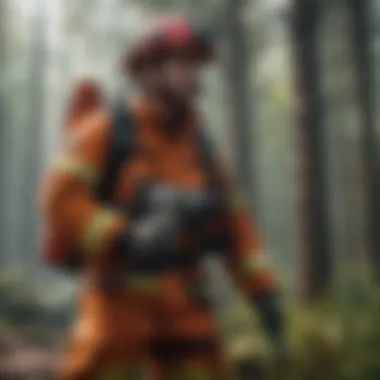Fire Fighting Services: Strategies for Woodland Ecosystems


Intro
Fire fighting services are indispensable in maintaining the health of woodland ecosystems. These services not only protect these critical habitats from destructive wildfires but also support biodiversity and climate stability. In this article, we will delve into the intricate roles played by firefighting strategies, equipment, and collaborative efforts in safeguarding our forests.
Understanding Woodland Ecosystems
Woodland ecosystems are complex and dynamic systems that house numerous species of flora and fauna. Understanding these environments is essential for effective fire management.
Importance of Biodiversity in Forests
Biodiversity refers to the variety and variability of life forms within a given ecosystem. In forests, biodiversity contributes to resilience against disturbances such as fires. Healthy ecosystems are often characterized by rich biodiversity. This diversity ensures a balanced food web and aids in the natural regulation of populations. Fire fighting efforts often prioritize the protection of these diverse environments, as they are pivotal for ecological stability.
Role of Forests in Climate Regulation
Forests serve as crucial carbon sinks, absorbing CO2 and mitigating climate change. They also influence local weather patterns and help regulate temperatures. When fires occur, the release of stored carbon compounds exacerbates climate change. Thus, effective fire fighting services are aimed not only at protecting life and property but also at sustaining the climate regulation that forests provide.
Sustainable Forestry Practices
Sustainable forestry practices are methods aimed at maintaining and improving the health of forest ecosystems while fulfilling human needs. Such practices are fundamental for long-term forest management and include various techniques.
Principles of Sustainable Forestry
Sustainable forestry emphasizes the importance of maintaining forest ecosystems, which includes:
- Preservation of biodiversity.
- Soil conservation.
- Water resource management.
- Minimizing waste and pollution.
Incorporating these principles not only aids in effective fire management but also aligns with broader environmental goals.
Case Studies of Successful Implementations
Several unique case studies highlight successful sustainable forestry implementations. For example, in Sweden, the approach of adaptive forest management has shown significant success in both reducing wildfire risks and enhancing biodiversity. In California, community-based programs have improved local resilience through education and resource allocations. These examples provide valuable insights for implementing or improving fire fighting services in other regions.
Woodland Stewardship Techniques
Effective woodland stewardship is vital for the long-term health and safety of forested areas. This encompasses various techniques and strategies focused on the management of forest resources.
Forest Management Plans
Forest management plans outline procedures and regulations aimed at sustainable resource use. They often include assessments of potential wildfire risks, invasive species management, and regular monitoring. Properly designed forest management plans can significantly enhance the effectiveness of fire fighting services by identifying vulnerable areas and preparing appropriate response strategies.
Conservation Strategies
Conservation strategies may include:
- Creating firebreaks to slow or stop the spread of wildfires.
- Controlled burns to manage underbrush and reduce fuel loads.
- Community education initiatives to inform the public about fire risks and prevention.
These strategies play integral roles in reinforcing the overall objectives of fire management while promoting the long-term sustainability of woodland ecosystems.
"The intersection of fire management practices and ecological conservation is crucial for the health of our forests and communities."
Understanding Fire Fighting Services
Fire fighting services are integral to managing and preserving woodland areas. These services involve not only responding to fires but also proactive measures aimed at preventing wildfires. As wildfire incidents increase globally, mainly due to climate change and human activities, understanding fire fighting services becomes increasingly vital.
Effective fire fighting involves multiple facets, including the deployment of specialized staff and equipment, community awareness programs, and coordination with various agencies. The importance of collaboration cannot be overstated; a unified approach enhances preparedness and response capacity.
Definition and Scope
Fire fighting services refer to a set of organized activities and resources dedicated to managing fire incidents, particularly in woodland environments. This includes combating wildfires, conducting controlled burns, and implementing preventive measures.
The scope of these services encompasses:
- Assessment of fire risks in woodland areas
- Planning and executing fire suppression strategies
- Educating communities on fire prevention


With an understanding of the definition, we can appreciate the broader scope of responsibilities that fire fighting services have in protecting ecosystems and communities from fire hazards.
Historical Evolution
The evolution of fire fighting services in woodland settings traces back centuries. Initially, fire management was rudimentary, focused largely on suppression without significant understanding of ecological implications. Over time, recognition grew regarding the importance of controlled burns and other preventive strategies.
Key milestones in the historical timeline include:
- The establishment of organized fire brigades in the 19th century, dedicated to urban as well as woodland fire control.
- The introduction of scientific methods in the 20th century that allowed for better understanding of fire behavior and ecosystem health.
In recent decades, a shift toward a more comprehensive fire management strategy has emerged. This approach includes mitigating the impacts of fire, promoting ecosystem resilience, and ensuring sustainable forestry practices. Understanding this evolution informs current practices and prepares us for future challenges in fire management.
The Role of Fire Fighting Services in Woodland Areas
Fire fighting services play a vital part in managing woodland environments. These areas are prone to wildfires due to their dense vegetation and varied climate conditions. Therefore, the strategies employed by fire fighting services are critical for not just the immediate protection of forests but also for the long-term health of ecosystems.
Fire fighting services in woodlands help in achieving several important objectives. They prevent the spread of wildfires, safeguard wildlife habitats, and protect human lives and property. Additionally, these services ensure that forest ecosystems remain intact and continue to provide essential resources and services, such as clean air and water.
Wildfire Prevention
Wildfire prevention is the primary mission of fire fighting services in woodland areas. Effective prevention techniques require a multifaceted approach that encompasses both community engagement and technical measures.
- Education and Awareness: Fire fighting services often engage in community outreach programs. Educating residents about fire safety and the importance of fire prevention helps reduce human-caused wildfires.
- Controlled Burns: Conducting prescribed burns is an effective method to reduce fuel loads in woodlands. By carefully managing these controlled burns, fire fighting services can significantly lower the risk of catastrophic wildfires.
- Firebreaks Creation: Establishing firebreaks is a common strategy to slow down or redirect the spread of fires. These are gaps in vegetation that can inhibit fire progression and protect nearby homes.
- Monitoring and Surveillance: Regular monitoring of forest conditions and early detection systems can help identify potential fire hazards. Drones and satellite technology are increasingly used in this aspect for ongoing assessments.
The importance of wildfire prevention cannot be overstated. Preventing fires saves lives, protects natural resources, and conserves financial resources that would otherwise be spent on fighting uncontrolled blazes.
Mitigation Strategies
Mitigation strategies are essential for reducing the impact of wildfires when they occur. Fire fighting services employ various methods to manage situations when prevention efforts are not enough.
- Quick Response Teams: Rapidly deploying teams to the fire scene minimizes damage. Specialized firefighter units are trained to tackle woodland fires efficiently.
- Resource Allocation: Determining the best use of available resources is crucial. Fire engines, water tenders, and aerial units are strategically positioned to respond swiftly.
- Collaboration with Local Authorities: Fire fighting services coordinate with local governments and other organizations. This collaboration allows for unified command structures and resource sharing during wildfire incidents.
- Post-Fire Rehabilitation: After a wildfire, the recovery process is vital. Fire fighting services often engage in efforts to restore damaged habitats, soil, and vegetation to promote ecological recovery.
Effective mitigation strategies not only reduce the immediate dangers posed by wildfires but also facilitate recovery efforts. They enable communities and ecosystems to bounce back from such disastrous events.
"Through proactive wildfire prevention and responsive mitigation initiatives, fire fighting services serve as a bulwark against the unpredictable fury of nature in woodland environments."
Fire Fighting Techniques in Woodlands
Fire fighting techniques are vital for effective management of woodlands, especially in the face of increasing wildfire incidents. These techniques not only help in containing fires but also ensure the preservation of vital ecosystems. Understanding the varied methods of fire fighting enhances the overall effectiveness of response strategies. Proper execution of these techniques can dramatically reduce the potential damage of wildfires and protect human life and property.
Ground-Based Methods
Ground-based fire fighting methods are fundamental in wildfire management. These strategies involve direct intervention by fire fighters who access the area on foot or using vehicles.
- Crews and Hand Tools: Firefighters often utilize hand tools such as shovels, axes, and rakes to create fire lines. These are essential in removing vegetation that fuels wildfires, preventing the spread of fire.
- Fire Engines: Specialized fire engines can navigate through rugged terrain. They are equipped with water tanks, hoses, and unroll the hose to directly attack flames. Fire engines provide quick response capabilities, allowing for real-time action.
- Controlled Burns: This technique involves intentionally setting small fires. These fires consume fuel that could feed larger wildfires later. Controlled burns also restore ecological balance by promoting new plant growth. Regular implementation of controlled burns can mitigate the severity of future wildfires.
A significant aspect of ground-based methods is training and teamwork. Fire crews are often composed of trained volunteers and professionals who perform in high-pressure situations. Their ability to work cohesively influences the success of the operation.
"Coordination and swift deployment of fire fighting teams is critical in minimizing wildfire impacts."
Despite the effectiveness of ground methods, challenges persist. Accessibility to remote woodland areas can be limited due to terrain. Additionally, adverse weather can hinder operational capabilities.
Aerial Resources
The use of aerial resources is increasingly becoming a staple in fire fighting strategies for woodlands. Aerial support provides a strategic vantage point that ground crews may not have.
- Helicopters: Helicopters can drop water or fire retardant directly over fires. They can swiftly cover large areas that may be inaccessible to ground crews. Their agility allows for quick relocations during changing fire conditions.
- Air Tankers: Larger aircraft can carry significant loads of water or fire retardants. Their ability to cover vast sections of a fire allows for rapid containment, especially during initial attack phases.
- Drones: Although still developing, drones are becoming useful tools for surveillance. They can monitor fire progression and provide real-time data to command centers. This technology enhances situational awareness for overall strategy planning.
The integration of aerial resources forms a multi-faceted approach to fire management. They allow for a coordinated response that combines both ground and aerial tactics. Importantly, utilizing aerial resources also enables a quicker response to newly ignited blazes, providing a critical advantage in containment efforts.
Equipment Utilized in Fire Fighting
The role of equipment in fire fighting cannot be overstated. Proper utilization of advanced tools ensures that firefighting teams can respond effectively in woodland environments. These resources enable improved safety, enhance response times, and optimize the processes involved in managing wildfire incidents. As wildfires continue to pose threats to ecosystems and communities alike, understanding the types of equipment available becomes vital for both firefighters and forestry professionals.


Personal Protective Equipment (PPE)
PPE is essential gear for fire fighters, designed to protect individuals against the various hazards encountered while working in woodland areas. This includes helmets, flame-resistant clothing, gloves, and boots. Each component serves a specific purpose. For example, helmets safeguard against falling debris, while flame-resistant clothing reduces the risk of burns.
Additionally, PPE must be comfortable, allowing for mobility and ease of movement. The stress of combating blazing fires demands agility and endurance, thus, a well-fitted gear is critical. Regular training on proper usage and maintenance of PPE ensures it remains in prime condition, ready to shield personnel from hazardous environments.
"Properly fitted and maintained PPE is often the first line of defense for fire fighting teams."
Fire Engines and Specialized Vehicles
Fire engines equipped for woodland firefighting differ significantly from typical urban fire trucks. Specialized vehicles, such as brush trucks and water tenders, are designed to traverse rugged terrain and access remote areas. These machines can carry water, fire retardants, and necessary tools, making them effective in reaching the front lines of a fire.
In addition to mobility, fire engines are fitted with powerful pumps to extract water from nearby sources, such as rivers or lakes. This capability is crucial in regions where it is not feasible to rely on a constant water supply. Furthermore, these vehicles often feature advanced navigation and communication technology to enhance operational efficiency during emergencies.
Communication and Monitoring Tools
Effective communication is a cornerstone of firefighting efforts, especially in complex woodland ecosystems. Tools such as two-way radios and satellite communication devices facilitate coordination among various agencies and teams. Clear lines of communication prevent confusion and duplication of effort when responding to fires.
Monitoring tools like thermal imaging cameras provide critical information about fire behavior and hotspots. Such technology enhances situational awareness, enabling fire fighters to make informed decisions in real-time. The integration of drones for aerial surveillance is an emerging trend that offers invaluable insights into large-scale incidents. This allows teams to plan strategically, ultimately contributing to safer and more effective firefighting efforts.
Each piece of equipment serves a definitive purpose, collectively enhancing fire fighting services in woodland environments. As trends and technology evolve, continuous evaluation of equipment effectiveness will be necessary to adapt to changing conditions and improve response strategies.
Collaboration Among Fire Fighting Services
Collaboration among fire fighting services is essential for effective management and response in woodland environments. The complexities of wildfires demand a unified approach, where multiple agencies work together towards a common goal: to protect life, property, and natural resources. Each agency brings its own expertise, resources, and strategies, making inter-agency cooperation vital.
Inter-Agency Cooperation
Inter-agency cooperation refers to the collaboration between different fire fighting organizations, government bodies, and non-governmental agencies. This cooperation enhances resource sharing and minimizes response times during fire outbreaks. Several factors contribute to its success:
- Shared Resources: Agencies can pool their assets, such as firefighting equipment and manpower. This shared approach alleviates pressure on individual organizations that may face resource limitations.
- Strategic Coordination: Developing a coordinated strategy helps in avoiding duplication of efforts. Agencies must establish communication channels to share intelligence about wildfire behavior and resource status in real time.
- Training and Best Practices: Collaborative training programs can be developed to standardize techniques and safety protocols across agencies. This uniformity leads to more effective and safer operations in high-risk areas.
The benefits of this cooperation are evident in the outcomes achieved during wildfire responses. When agencies work collectively, they can tackle larger fires with increased efficiency. The support that comes from inter-agency cooperation ensures that fire fighting services are well-prepared to face the challenges of woodland fires.
Community Engagement
Community engagement is another critical aspect of collaboration in fire fighting services. Involving local communities can provide valuable insights into forest conditions and existing risks. This engagement focuses on building relationships and promoting awareness among residents:
- Educational Programs: Fire fighting agencies can lead workshops and training sessions aimed at educating the community about fire safety practices and prevention strategies. An informed public is more likely to take proactive measures.
- Volunteer Programs: Local community members can serve as volunteers. Their knowledge of local topography and ecology can be invaluable during firefighting efforts. Engaged citizens can assist in non-combative roles, such as clearing brush and monitoring fire conditions.
- Feedback Mechanisms: Establishing channels for community input will allow fire fighting services to learn about local concerns. This feedback can shape future policies and procedures, ensuring the services are relevant and effective.
Engagement fosters trust and cooperation between fire services and communities. When people understand the actions taken by fire fighting services, they are more likely to support them in times of crisis. Strong community ties result in a more resilient approach towards wildfire management.
"Effective fire fighting in woodlands is not solely dependent on resources; it hinges on collaboration among diverse entities and the engagement of local communities."
Challenges Faced by Fire Fighting Services
Fire fighting services encounter various challenges that hinder their effectiveness in woodland environments. These obstacles are critical to understanding, as they impact not only the operational capacity of the services but also the overall safety of forested areas. Addressing these challenges is essential for developing more resilient and effective fire management strategies.
Resource Limitations
Resource limitations frequently constrain fire fighting efforts in woodland areas. Funding and budget deficiencies often lead to a lack of essential equipment, personnel, and training resources. Many fire departments operate with outdated vehicles and equipment, reducing their ability to respond swiftly and effectively. Additionally, many rural areas experience workforce shortages. Many volunteer fire brigades struggle to attract and retain sufficient numbers of trained personnel. In some cases, professional firefighters are stretched thin, impacting their ability to respond to multiple incidents simultaneously.
An inadequate supply of water sources within woodland areas can complicate firefighting efforts. If predetermined water resources are insufficient or inaccessible, it delays response time and compromises safety. Furthermore, there are often disputes regarding funding allocations between various governmental agencies that are responsible for forest management.
Environmental Changes
Environmental changes pose significant challenges to fire fighting services. Climate change has contributed to hotter and drier conditions, which exacerbate the frequency and intensity of wildfires. Many woodland areas now experience longer fire seasons, which places additional strain on fire management teams. Altered weather patterns can create unpredictable fire behavior, complicating containment efforts.
Moreover, invasive plant species increase fuel loads in forests, leading to faster-spreading fires. Fire fighting teams must constantly assess and adapt to these evolving conditions in order to provide efficient responses. The growth of urban interfaces in wooded areas also presents a challenge. The mingling of residential areas with forests can result in increased human-caused ignitions, which complicate fire management strategies.
Risk to Personnel
The risks faced by fire fighting personnel can be immense and are a fundamental aspect of their work. Operating in remote wilderness areas presents unique hazards, such as rugged terrain and limited access. Firefighters often encounter unpredictable and rapidly changing fire behavior, which can threaten their safety. Additionally, fatigue from extended operations can lead to compromised decision-making skills, further increasing the potential for accidents and injuries.


Injuries are another concern for fire fighting teams, especially when dealing with hazardous materials found in certain environments. Firefighters may be exposed to toxic chemicals or harmful substances as they combat blazes, which could lead to chronic health issues down the line. Mental health challenges also arise from the stressful nature of the work and exposure to traumatic events, requiring ongoing support and intervention.
Effective training and mental health resources are critical for mitigating these risks and ensuring that personnel can operate safely and efficiently.
Technological Advances in Fire Fighting
The rapid progression of technology in recent years has greatly influenced fire fighting services, particularly in woodland environments. Technological advances have improved the techniques and strategies deployd by firefighting agencies, leading to more efficient responses in wildfires and better overall management of forest ecosystems. In this segment, we will delve into specific technological innovations, their applications, and the benefits they offer to firefighting teams.
Use of Drones
Drones, or unmanned aerial vehicles (UAVs), have become a vital tool in modern fire fighting. Their ability to provide real-time aerial surveillance offers fire fighters a comprehensive view of the area affected by wildfires. Drones equipped with thermal imaging cameras can detect heat signatures even through dense smoke, helping in locating hotspots and assessing the fire's progression. This information is crucial for planning effective containment strategies.
Some specific benefits of using drones include:
- Enhanced Situational Awareness: Firefighters can evaluate the landscape without putting themselves at risk.
- Data Collection: Drones gather data on fire behavior, vegetation types, and terrain, which informs future operations and fire prevention methods.
- Cost Efficiency: Utilizing drones can be more economical than traditional aerial firefighting methods like helicopters, making these tools more accessible.
Furthermore, drones can deliver payloads such as fire retardants to hard-to-reach areas. This capability allows for a rapid response to outbreaks before they escalate, improving the chances of containing a wildfire early on.
"The integration of drones in firefighting operations has revolutionized how teams approach wilderness fire management."
Predictive Modeling
Predictive modeling utilizes advanced algorithms and data analytics to forecast potential wildfire behavior and growth. This technology leverages historical data, environmental variables, and real-time information to predict how a fire may spread. For fire fighting services, this means being one step ahead in planning, resource allocation, and deployment strategies.
The advantages of predictive modeling include:
- Effective Resource Allocation: Fire managers can deploy units and equipment strategically based on predicted fire paths, ensuring that resources are directed where they are most needed.
- Enhanced Decision Making: Data-driven models provide insights that influence tactical decisions, minimizing risks to personnel and maximizing effectiveness in addressing wildfires.
- Public Safety: By predicting fire movements, evacuations can be planned more accurately, ensuring the safety of communities adjacent to woodland areas.
In summary, the incorporation of advanced technology such as drones and predictive modeling in fire fighting services plays a fundamental role in modern fire management of woodland ecosystems. These innovations contribute to efficient operations, heightened safety, and improved outcomes in the face of increasingly severe wildfire events.
Best Practices for Fire Fighting in Woodlands
Fire fighting in woodland environments requires precision and well-established practices to ensure the safety of both firefighters and the surrounding ecosystem. Understanding and implementing best practices is instrumental in minimizing risks, effectively managing fires, and enhancing overall fire response capabilities. These practices not only focus on direct firefighting techniques but also encompass training, preparation, and continuous improvement for teams involved in woodland fire management.
Training and Education
Training and education are paramount in equipping fire fighters with the knowledge and skills necessary to succeed in woodland environments. Effective training programs should cover a wide range of scenarios that firefighters may face, including the behavior of wildfires, proper use of equipment, and techniques for fire suppression. This education goes beyond hands-on training, involving classroom components where theories and strategies are discussed.
Moreover, educational initiatives should emphasize the unique characteristics of woodland fire behavior. Understanding factors such as weather conditions, vegetation types, and terrain can drastically affect firefighting outcomes. It is also essential that fire fighters receive continuous training on the latest technology and methods being deployed in the field to keep pace with evolving challenges.
Regular workshops and seminars can foster ongoing education. These events allow firefighters to share experiences, discuss lessons learned, and adopt new practices from colleagues in the field. Investing in robust training programs ultimately leads to a more prepared firefighting workforce, capable of swift, informed responses in crises.
Regular Drills and Preparedness
Regular drills are a critical component of a successful fire fighting strategy in woodlands. These drills simulate real-life scenarios, which help firefighters practice their responses and refine their skills under pressure. By scheduling these exercises, fire departments can identify gaps in their procedures and address them before actual incidents occur.
Preparedness also includes maintaining a well-organized inventory of equipment and supplies. Firefighters need access to the right tools and protective gear, and routine checks are essential to ensure functionality. This equipment can include everything from fire engines to hand tools specifically designed for forestry fire fighting.
Furthermore, communicating effectively among team members during drills reinforces the importance of teamwork. Strong communication channels can make a difference in fast-paced situations when decisions need to be made quickly. Engaging community members in preparedness efforts through training sessions and informational workshops also builds awareness and resilience against potential wildfires, enhancing the overall safety of woodland areas.
The Future of Fire Fighting Services
The landscape of fire fighting services is continuously changing due to advances in technology, evolving environmental conditions, and shifts in policy and public perception. Understanding these changes is key for forestry professionals and those involved in fire management. Effectively addressing the challenges that arise will require innovative approaches and strategies that adapt to the complexities of woodland environments. As fires become more frequent and severe, a proactive stance will be essential.
Emerging Trends
Emerging trends within fire fighting services include the integration of advanced technologies and methods that enhance firefighting capabilities.
- Drones and UAVs: The use of drones for aerial surveillance has grown. Drones provide real-time data on fire progression and help in assessing difficult areas to reach. They allow for more precise application of water or retardants.
- Remote Sensing Technology: Technologies like satellite imagery and thermal imaging help detect hotspots and monitor fire behavior. This helps in planning strategies for containment more effectively.
- Collaboration with Research Institutions: There is increasing collaboration between fire services and research organizations. This partnership leads to the development of predictive models and improved fire management strategies based on empirical data.
- Sustainable Practices: Emerging practices also focus on sustainable forest management, including controlled burns and thinning. These methods help reduce fuel loads and minimize the risk of major wildfires.
- Training and Development: Training programs are increasingly incorporating new technologies, ensuring firefighters are prepared to utilize advanced tools effectively. Continuous education is vital to stay ahead in fighting wildfires.
Policy Recommendations
Aligning policies with the dynamics of forestry and fire management is essential for effective fire fighting services. Key recommendations include:
- Funding for Research and Development: Allocate more resources towards developing innovative fire fighting technologies and methods. Investment in research can lead to breakthroughs that enhance the safety and efficiency of fire services.
- Inter-Agency Policy Coordination: Establish clear policies that ensure cooperation among various agencies involved in firefighting and land management. This can enhance resource sharing and operational efficiency during emergencies.
- Public Awareness Programs: Implement educational campaigns that inform communities about fire risks and the importance of active forest management. Awareness initiatives can empower local residents to participate in prevention efforts.
- Tax Incentives for Sustainable Practices: Provide incentives for landowners to engage in practices that promote forest health and reduce hazardous fuel loads. Encouraging landowners to adopt these measures will be crucial in mitigating fire risks.
- Emergency Preparedness Plans: Establish comprehensive evacuation and response plans that involve all stakeholders, including local residents. Preparation can minimize the impact of wildfires and protect lives and property.
"Adapting fire fighting services to the realities of modern woodland environments is not just important; it is essential for the resilience of our ecosystems and communities."
In closing, the future of fire fighting services relies heavily on the integration of innovative technologies, strong policies, and community engagement. Understanding these trends is critical to navigate the complexities of woodland fire management successfully.







